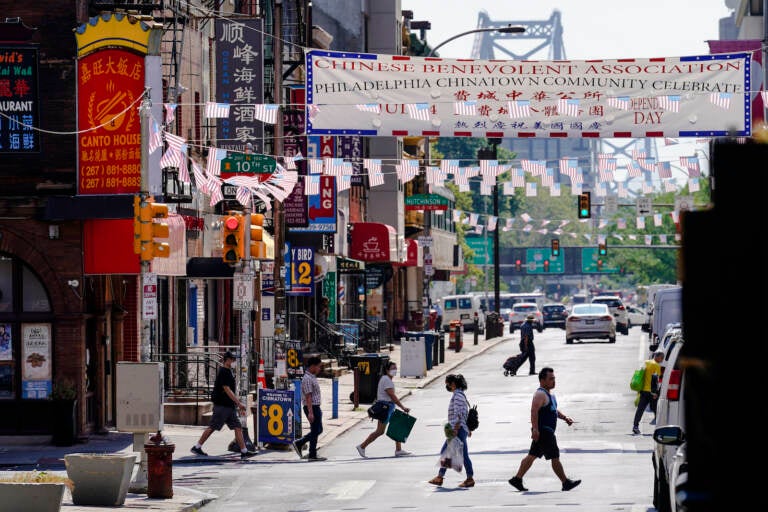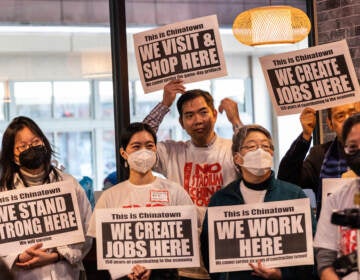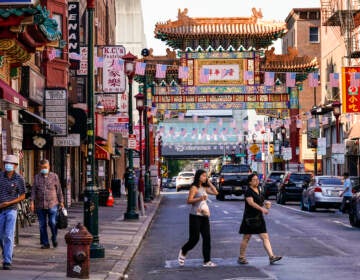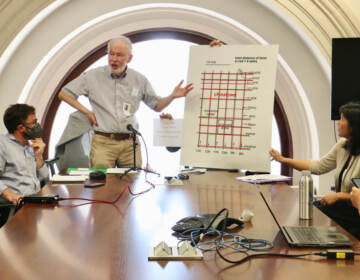Proposed Sixers arena could cost millions in lost tax revenue, new analysis finds
The analysis comes as stakeholders await the results of two impact studies commissioned through the city.
Listen 6:16
Pedestrians walk in the Chinatown neighborhood of Philadelphia, Friday, July 22, 2022. (AP Photo/Matt Rourke)
What you need to know
- The 76ers have proposed moving to a new $1.55 billion arena near Chinatown called “76 Place”
- The proposal has drawn swift condemnation, excitement, skepticism — and plenty of buzz
- Black Clergy of Philadelphia has endorsed the project, while a majority of Chinatown businesses and other community members have voiced their opposition
- Amid competing interests, the arena’s future remains uncertain
A new analysis finds that 76 Place could cost Philadelphia and Pennsylvania more than $1 billion in lost tax revenue, a scenario that would nearly offset the public revenues the team says a downtown arena would generate.
Released Thursday, the study considers the potential impact the $1.55 billion project could have on local businesses, particularly those dedicated to food and entertainment. It shows that disrupting that economy, during construction and once the arena opens, could mean less money for the city and state in the form of sales and wage taxes, as well as the city’s business and receipts tax.
“It’s possible that there might actually be no impact or a positive impact. But under a relatively conservative scenario, there will be some negative impact on existing businesses due to increased congestion, traffic during the construction period, people avoiding the area as some of the streets will be closed and all the traffic patterns will be disrupted,” said Dr. Arthur Acolin, the Bob Filley Endowed Chair in the Department of Real Estate at the University of Washington.
Acolin’s analysis is rooted in research exploring the impact of sports facilities on local economies. It comes as stakeholders await a pair of highly-anticipated impact studies commissioned through the city and paid for by the Sixers. The studies, which do not have a release date, will focus on the economic and community impacts of building an arena on Market Street arena near Chinatown, which roundly opposes the project.
A spokesperson for 76 DevCo, the Sixers’ development arm, called the study “fatally flawed” and “haphazard.”
The study looks at the impact the arena could have on the commercial core of Chinatown, but also the thousands of surrounding businesses that share the 19107 ZIP code, including those in Washington Square West and Midtown Village.
The analysis finds the 2,200-plus businesses in the broader area around the arena generate $296 million in tax revenue annually. As a result, the study projects the arena could cost the city and state anywhere between $264 million and $1 billion in lost tax revenue — during the five years it’s expected to take to build the arena, and the 30 years it’s expected to be open at the proposed site.
In addition to the negative impacts of traffic congestion, Acolin said he suspects most fans and concert-goers won’t patronize local businesses, and will instead spend their money at concession stands inside the arena or patronize new businesses that spring up as a result of the arena being built.
“A lot of the studies that are made to support any new project, they take into account what jobs and what activities are created by the investment, but they don’t really take into account the substitution effect. The fact that you’ll have customers who have gone to an existing restaurant that will then go to that new restaurant. That you have existing shops that will lose some customers because they will have some newer, fancier shops that will open,” said Acolin.
Since announcing its proposal in July 2022, the Sixers have said the arena will be a boon for the city, particularly the blocks east of City Hall, which have struggled to thrive for decades despite millions in investment.
To bolster its argument, the team released an analysis showing the arena would generate an estimated $1.5 billion in new tax revenue for Philadelphia, its school district and the state —- revenues they say would not be available if the Sixers stayed at the Wells Fargo Center in South Philadelphia, where the team has played for nearly three decades.
Have a question about Philly’s neighborhoods or the systems that shape them? PlanPhilly reporters want to hear from you! Ask us a question or send us a story idea you think we should cover.
A Sixers’ spokesperson has said the findings are based on the results of a commissioned study. The results of that study were not publicly released.
In a statement, the team said Acolin’s study is grounded in underlying research and citations that “do not actually reach the stated conclusions.”
“Amid this haphazard report’s myriad of issues, there is no explanation of how the researcher arrived at his data, assumptions, or conclusions. If it exists, we encourage the author to submit it to the City for independent analysis as we have done,” said spokesperson Mark Nicastre.
“This should be read for what it is: another attempt by those who oppose the project to obfuscate the truth by pumping out misinformation and half-baked theories instead of engaging in productive dialogue,” said Nicastre.
Bishop Dwayne Royster of POWER interfaith, a member of the Save Chinatown Coalition, said in a statement that the study “reinforces that 76 Place would be a monument to exploitation and come at a high cost to children, families, and taxpayers.”
“Lost wages for Black workers, the erasure of small businesses, and a loss of $1 billion in tax revenue will deepen existing inequality and harm the people who need the most and already get the least,” said Royster.
The Sixers hope to open the new arena in 2031, the same year its lease is up at the Wells Fargo Center. The project needs zoning approval before construction can start. That process is expected to play out in City Council later this year — after the impact studies are released.

Subscribe to PlanPhilly
WHYY is your source for fact-based, in-depth journalism and information. As a nonprofit organization, we rely on financial support from readers like you. Please give today.








